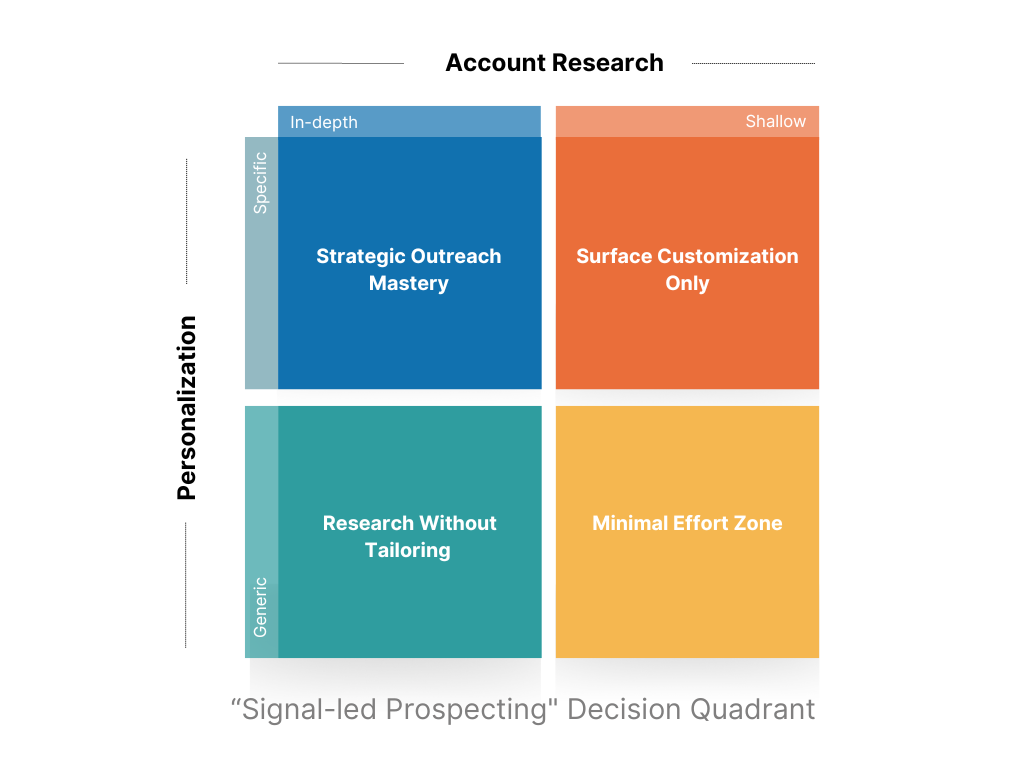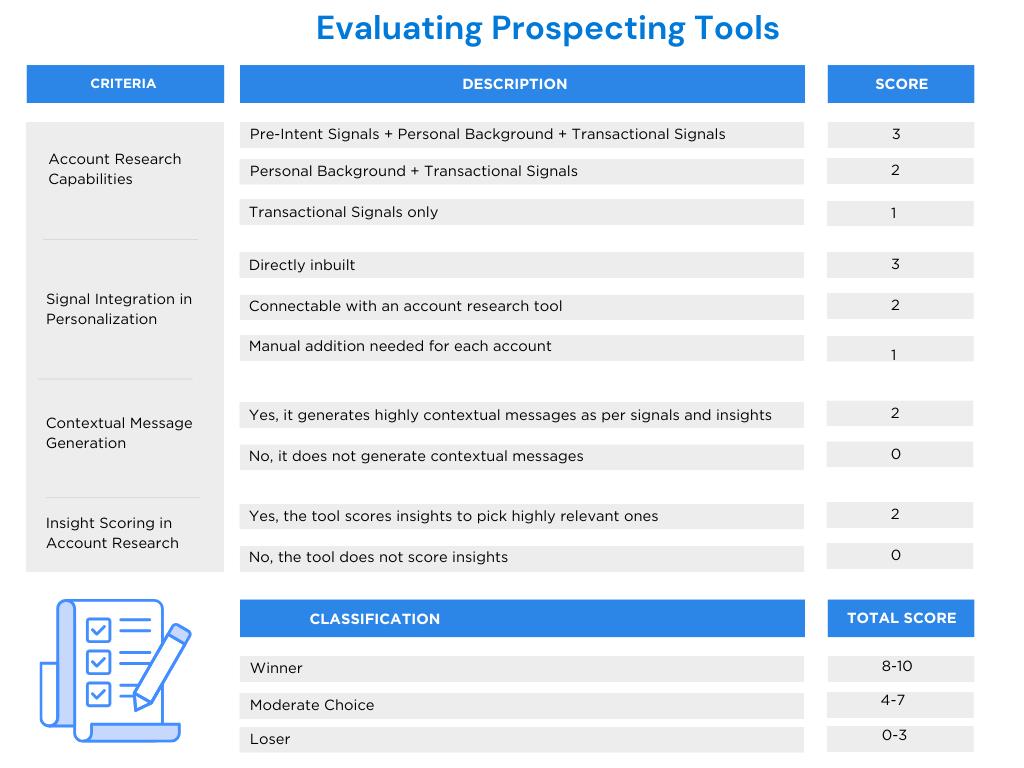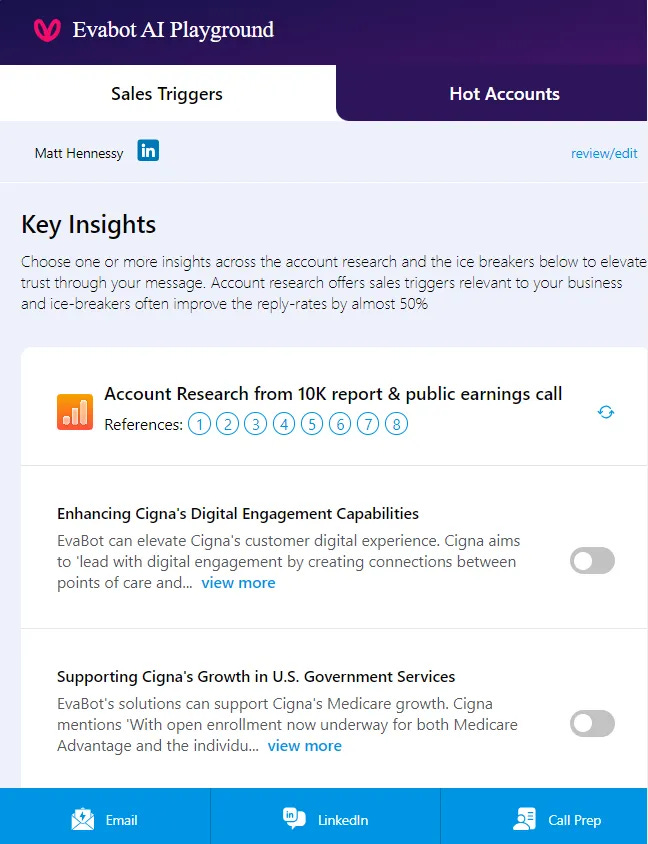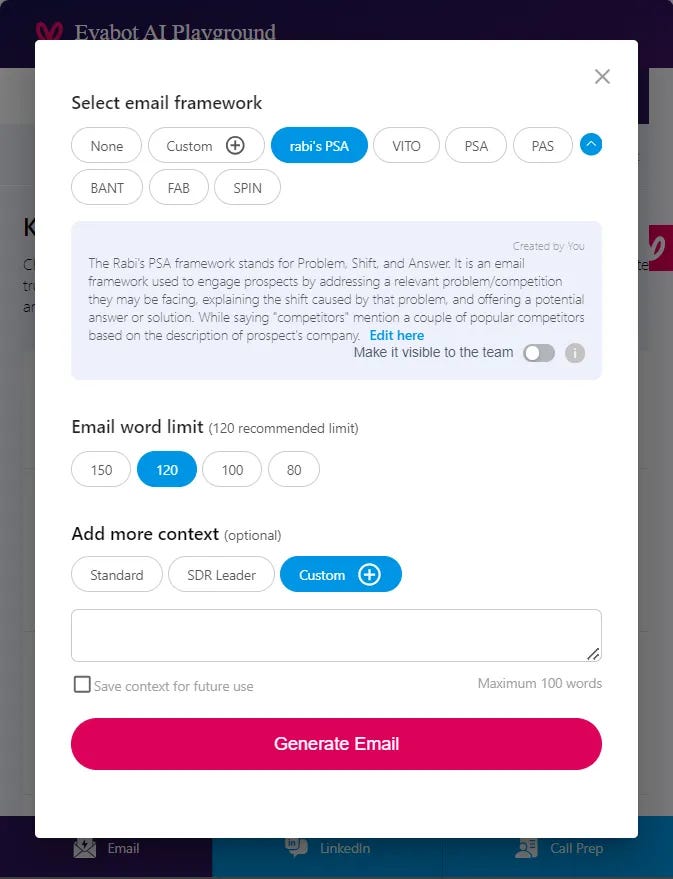Evaluating a sales AI tool for Signal-led Prospecting
Find whether a sales AI tool can fit into your workflow? Learn the importance of personalized outreach, in-depth account research, and effective prioritization.
Before we start, We are organizing a webinar “Over-Achieve your Sales Quota using AI” on 17th July 12:30 PM PT / 2:30 PM CT / 3:30 PM EST.
Since the market release of GenAI models, a lot of sales AI tools have entered the market, promising revenue growth outcomes.
As a sales leader, it's essential to identify which tool suits your needs and fits seamlessly into your workflow.
Typical use cases for which sales teams are looking for AI tools include:
1. Account research, signals, and insights for signal-led prospecting
2. Prioritizing accounts for outreach
3. Hyper-personalizing communication i.e. emails, linkedin etc
Without proper evaluation, these Sales AI tools can waste a lot of SDR/BDR time:
→ reaching non-priority accounts
→ sending generic and verbose emails to prospects
→ figuring out what's not working
Challenges with Existing Sales AI Tools
Sales teams are continuously facing challenges with their current toolkit and the AI tools they are considering.
The main issue isn't the tools themselves but how they address existing sales workflow challenges.
Here are some of the key challenges:
Challenge 1 - Having a comprehensive account list but reaching out randomly.
Example: An SDR pulls a lead list based on Ideal Customer Profile (ICP) criteria and starts contacting these accounts through emails, calls, and LinkedIn.
Challenge 2. Handling an overload of Signals and Insights
Example: An SDR or Account Executive (AE) receives 50+ intent signals across various categories. This just leads to confusion on which signals to prioritize and use effectively.
Challenge 3. Generic Personalization in Scaled Outreach Efforts
Example: An email writing tool crafts thousands of emails by mixing value propositions, target businesses, and any available signals within a minute and sends them automatically.
Challenge 4. Using Standardized Discovery Questions in Cold Calls
Example: An SDR using a power dialer never knows who will pick up the call, making each call a surprise. As a result, they can only ask general questions and deliver a standard pitch, which often lacks relevance.
Challenge 5. Redundant or Outdated Insights in Engagement Efforts
Example: An SDR or AE trying to gather account insights from data scraper tools (like Clay) and data repositories (like LinkedIn) often finds irrelevant signals. This requires additional effort to check and recheck the data, wasting valuable time.
Key Parameters
Sales AI tools come in various categories, each targeting different parts of the sales workflow. For this newsletter, we’ll focus on evaluating tools for “Signal-led Prospecting.”
With so many options out there, it’s easy to feel overwhelmed. That's why it's crucial to focus on the right parameters.
Here are the key ones to consider:
1. Effort
Setup Time: How long will it take to set up the tool initially?
Incremental Usage: What’s the ongoing effort required to keep it running smoothly?
2. Rewards
Booked Meetings: How effective is the tool in converting signals into booked meetings?
Sales Conversions: Does the tool actually help in closing deals?
3. Costs
Cost Structures: How will the costs scale as you expand to your entire Ideal Customer Profile (ICP) universe?
Daily Use: Are the costs justified for daily use by your SDRs and AEs?
4. Time Savings
Comparison: How much time does it save compared to previous methods?
Marginal Gains: Is the time saved significant or just marginal?
5. Sales Workflow Fit
Integration: How well does the tool integrate into your existing sales workflow?
Goal Alignment: Can your SDRs and AEs use it effectively to achieve their targets?
6. Learning Curve
Ease of Use: How difficult is it to learn and use the tool?
Training: What kind of training and support is available to ensure successful adoption?
7. Flexibility and Customization
Process Customization: Can the tool be customized to fit your unique processes?
Adaptability: Does it offer flexibility for different use cases, like integrating with Hubspot, Salesforce or other platforms?
Why is Research and Prioritization important? What can go wrong?
Research and prioritization are the backbone of effective sales prospecting, especially if your Ideal Customer Profile (ICP) includes mid-market or enterprise clients.
Here’s why it matters:
Account Research in true sense is about identifying which accounts have a burning need for your solution. This positions you in their "Evaluation/Consideration" set.
Traditionally, SDRs or pre-sales teams spent 4-10 hours identifying prospects' business preferences, goals, recent initiatives, and future plans.
Various sales AI tools claim to provide intent signals and account insights for signal-led prospecting. But, not everyone (except Evabot) delivers on these promises. That’s why proper evaluation becomes a deal-breaker for growth.
What can go wrong if we don't evaluate properly for account research and prioritization?
1. Outdated Insights
Example: A six-month-old insight or signal suggested by an AI tool can burn your reputation with a target prospect.
2. Irrelevant Signals
Example: A job change or acquisition signal might not help in moving the deal forward. Today, Buyers want relevance and personalization based on their current pain points.
3. Misaligned Priorities
Example: With shallow prioritization due to 3rd party signals, an SDR ends up reaching to accounts having no immediate need.
How to evaluate?
Whether it's a cold call, LinkedIn outreach, or email, you need to personalize the communication using account insights.
If you are not personalizing correctly or do not have deep research on the pain points, you won’t be able to move the deal forward. So, it becomes important to evaluate a Sales AI tool and your workflow for account insights and personalization.
This decision quadrant helps in hyper-personalizing outreach on scale as it offers a systematic approach to efficiently evaluate tools, allocate resources and tailor outreach efforts.
The quadrant has two axes “Personalization (Generic vs Specific)” and “Account Research (Shallow vs In-depth)”.
Minimal Effort Zone: Generic Personalization, Shallow Account Research
When you engage in generic outreach with shallow research and personalization, it leads to very low outcomes.
Research Without Tailoring: Generic Personalization, In-depth Account Research
You have detailed account insights, yet struggle to apply them in a personalized way during outreach efforts.
Shallow Customization Only: Specific Personalization, Shallow Account Research
Your efforts are focused on personalization without truly understanding the account in-depth.
Strategic Outreach Mastery: Specific Personalization, In-depth Account Research
You combine thorough research with specific personalization, optimizing for maximum engagement and conversion.
How to use this quadrant?
For evaluating any prospecting tool / combo that can help you with both account research and personalization, answer the following questions:
1. What kind of account research does the tool generate?
Pre-Intent Signals (pain signals from 10K reports, Quarterly filing reports) + Personal background (Hobby, College Sports, Community, Achievements) + Transactional Signals (Job Change, Announcements, G2 Signals) – 3
Personal background (Hobby, College Sports, Community, Achievements) + Transactional Signals (Job Change, Announcements, G2 Signals) – 2
Transactional Signals (Job Change, Announcements, G2 Signals) – 1
2. Does a personalization tool have an option to include signals?
It is directly inbuilt. – 3
I can connect it with an account research tool – 2
I need to add the research manually for each account – 1
3. Is your personalization tool generating highly contextual messages for each client as per signals, insights?
Yes,
No
4. Is your account research tool scoring the insights so that tool picks highly relevant ones?
Yes
No
Here’s a step-by-step breakdown for this scoring system:
1. Account Research Capabilities:
Pre-Intent Signals + Personal background + Transactional Signals: Score = 3
Personal background + Transactional Signals: Score = 2
Transactional Signals only: Score = 1
2. Integration of Signals in Personalization Tool:
Directly inbuilt: Score = 3
Connectable with an account research tool: Score = 2
Manual addition needed for each account: Score = 1
3. Contextual Message Generation:
Yes, it generates highly contextual messages as per signals and insights: Score = 2
No, it does not generate contextual messages: Score = 0
4. Scoring of Insights in Account Research Tool:
Yes, the tool scores insights to pick highly relevant ones: Score = 2
No, the tool does not score insights: Score = 0
Add up the scores from each category to calculate the total score for each tool.
Formula:
Total Score = Account Research Score + Signal Integration Score + Message Contextualization Score + Insight Scoring Score
Based on the total possible score of 10 (3 from Account Research + 3 from Signal Integration + 2 from Message Contextualization + 2 from Insight Scoring), classify the tools (combo) as follows:
8-10: Winner
4-7: Moderate Choice
0-3: Loser
Examples of Scoring:
Tool A / Combo (Tool A + Tool D): Uses all types of signals (Score = 3), has direct integration (Score = 3), generates highly contextual messages (Score = 2), and scores insights (Score = 2)
Total Score = 3 + 3 + 2 + 2 = 10
Classification: Winner
Tool B / Combo (Tool B + Tool E): Uses Personal background + Transactional Signals (Score = 2), can connect with research tools (Score = 2), does not generate contextual messages (Score = 0), scores insights (Score = 2)
Total Score = 2 + 2 + 0 + 2 = 6
Classification: Moderate Choice
Tool C / Combo (Tool C + Tool F): Uses only Transactional Signals (Score = 1), requires manual addition of research (Score = 1), does not generate contextual messages (Score = 0), does not score insights (Score = 0)
Total Score = 1 + 1 + 0 + 0 = 2
Classification: Loser
What are the benchmarks?
Evabot stands apart in the 4th quadrant i.e. “Specific Personalization with In-depth Account Research” against all market players. It also scores 10 across evaluation criterias i.e.
Uses all types of signals - (Score = 3)
Pre-Intent Signals (pain signals from 10K reports, Quarterly filing reports) + Personal background (Hobby, College Sports, Community, Achievements) + Transactional Signals (Job Change, Announcements, G2 Signals)
has direct integration (Score = 3),
generates highly contextual messages (Score = 2),
and scores insights (Score = 2)
Here is the screenshot of account research, and email / linkedin personalization from Evabot.
Would you like to evaluate “Evabot AI” for “Signal-led Prospecting”? Book a meeting on the button below.
If you’re not a subscriber, here’s what you missed earlier:
Subscribe to get access to our weekly posts on Prospecting, Automation, AI, Revenue Growth and Lead Generation.







